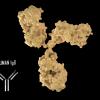Cone cells, or cones, are photoreceptor cells in the retina of the eye that function best in relatively bright light. The cone cells gradually become sparser towards the periphery of the retina. Approximately 4.5 million cone cells and 90 million rod cells in the human retina.
Humans normally have three kinds of cones. The first responds most to light of long wavelengths, peaking in the yellow region; this type is designated L for long. The second type responds most to light of medium-wavelength, peaking at green, and is abbreviated M for medium. The third type responds most to short-wavelength light, of a violet color, and is designated S for short.
The three types have peak wavelengths near 564–580 nm, 534–545 nm, and 420–440 nm, respectively. The difference in the signals received from the three cone types allows the brain to perceive all possible colors, through the opponent process of color vision.
Nanobotmodels Company made model of cone cell. It was composed on the ground of modern research and microscope images.
To learn more about this picture or obtain permission rights, contact us: info(at)nanobotmodels.com





